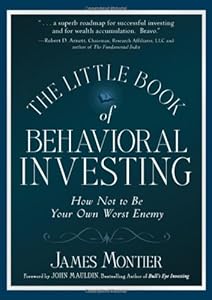Now here’s a book that really is about you, just as it claims. It’s a rare treat among the seriously brain freezing literature available on investment, all extremely knowledgeable I’m sure but dreadfully painful to read. “The Little Book of Behavioral Investing: How not to be your worst enemy” by James Montier grabs you from the very start because: (a) the author’s style is beguiling and amusing, (b) through the subtle humor, you get the message in all its clarity, (c) it’s extremely relatable. Many of the behavioral streaks mentioned in the book will resonate with readers, from the worst investor to the best. And even the best become their worst enemy at times, says Montier.
In the book’s introduction, Montier mentions a startling fact. According to the annual Dalbar studies, the S&P 500 has generated just over 8 percent on average each year, over the last 20 years. So perhaps individual equity investors can be tagged at 6 to 7 percent, yes? Wrong. Equity fund investors actually earn a paltry 1.9 percent per annum, primarily because of selling and buying at the worst possible times.
In his book, Montier discusses the human traits that make us take illogical and potentially expensive decisions. Thankfully, he also offers solutions to these challenges, most of which are fairly easy to practice, with some discipline. Through the book, Montier shares experiences of leading investors across the world. Like us, they too have succumbed to mental pitfalls at some time. It’s heartening to know, isn’t it? Montier hopes this book will make each of us look inwards, at our own human biases.
To our credit, it’s not really our fault. We can blame it all on evolution. Montier believes we’re still wired to fit into a world that existed 150,000 years ago. Our brains haven’t kept up with the change in our circumstances. Therefore, till we invent technology that brings our brains up to speed, you need this book.
Montier also makes an interesting analogy of our human biases with Star Trek’s Spock, logician and emotionally unsusceptible (but even he got confused at times) and McCoy, the ever emotional comrade. Our brain too has an X-system that aims to satisfy and please quickly, often drawing a picture based on our wishes rather than reality; and a C-system that’s driven by logic. It’s slower in drawing conclusions and as luck would have it, is harder to engage. Additionally, the X-system evolved before the C-system which explains why we are all driven by emotion. If you think you’re a Spock, get the book and get on with the CRT test. Tell me how it goes.
Cultivating our C-system takes perseverance, constant practice and time. It can also be mentally exhausting. Again, Montier has a solution. Now, it may be over-optimistic to believe that each of us will rise to John Templeton levels by the end of this book, but if it doesn’t make you rethink your investment strategies, well, I’ll eat my hat!
(PS: I live in India. I don’t wear a hat.)
Monica Samuel is doing a chapter-wise review of the book: The Little Book of Behavioral Investing: How not to be your worst enemy by James Montier. You can follow the series by following this tag: tlbbinvesting or by subscribing to this rss feed: tlbbifeed

